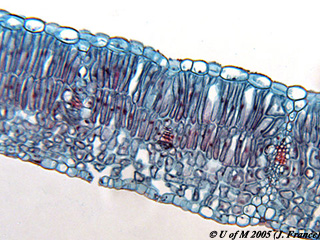
 |
The Leaf
as an Organ of Photosynthesis
-3.jpg) You
will recall that plants exhibiting the vascular plant level of organization
produce leaves which function as the principle photosynthetic organ of the sporophyte
generation. The subepidermal tissues of young stems, flower parts (i.e. sepals
and carpels) and fruits are often rich in chloroplasts and play a minor role
in the overall photosynthetic capacity of the plant body.
You
will recall that plants exhibiting the vascular plant level of organization
produce leaves which function as the principle photosynthetic organ of the sporophyte
generation. The subepidermal tissues of young stems, flower parts (i.e. sepals
and carpels) and fruits are often rich in chloroplasts and play a minor role
in the overall photosynthetic capacity of the plant body.
Leaves are a product of the shoot apical meristem and as such are a part of the primary growth phase of the plant. In contrast to the apical meristem itself which is indeterminate in growth, the growth of the leaf is of limited duration and determinate.
A "typical" leaf consists of a stalk, or petiole and a flattened blade (some leaves, e.g. grasses, lack petioles, the blade being sessile on the stem). In addition, some leaves bear small appendages, called stipules, at the bases of the petioles. The blade is usually broad and thin and contains a complex system of major and minor vascular bundles (veins). Because of the flatness of the blade, a large surface area in relation to its volume is exposed to light. The lignified cells of the vascular bundle (xylem vessels and tracheids) and surrounding tissues provide a supportive framework for the thin blade. If the plant has an adequate supply of water the mesophyll cells of the leaf blade will remain turgid. This results in a form of hydrostatic skeleton which maintains the rigidity and "crispness" of the leaf blade. The blade of a single leaf may be undivided and simple or it may be subdivided into leaflets and compound.
Leaf Arrangement
(Canadian Campbell, Fig 35.6).
The regions of the stem where leaves are attached are called nodes and the stem segments between them are internodes. The leaves on a stem are usually arranged in a definite pattern and are typically oriented so that each leaf is exposed to the light with a minimum of interference from other leaves.
There are four basic types of leaf arrangements:
In addition, leaves can be described as being:
Leaf Structure
(Canadian Campbell Fig 35.18)
The anatomy of the leaf of a terrestrial vascular plant is such that the loss of water by transpiration is reduced; atmospheric CO2 can be absorbed and once absorbed can readily diffuse to the photosynthetically active cells. The vascular tissue is in proximity to the photosynthetic cells and the leaf provides an expanded surface for light absorption.
 Examine
a prepared slide of a cross section through the blade of a typical dicot
(Syringa) leaf. Locate the upper epidermis, lower
epidermis, cuticle, palisade mesophyll,
spongy mesophyll, major and minor vascular bundles,
xylem, phloem, stomata and
guard cells.
Examine
a prepared slide of a cross section through the blade of a typical dicot
(Syringa) leaf. Locate the upper epidermis, lower
epidermis, cuticle, palisade mesophyll,
spongy mesophyll, major and minor vascular bundles,
xylem, phloem, stomata and
guard cells.
In surface view the guard cells of the leaf epidermis are typically crescent- shaped. Unlike the other cells of the epidermis the guard cells contain chloroplasts. The inner walls of the two guard cells, surrounding the lens shaped stoma, are thickened.
View an epidermal peel from the lower surface of the leaf provided, mount it on a slide in water, and examine the guard cells and stomata in surface view.
Elodea is an aquatic vascular plant belonging to the Class Angiospermae.
View an Elodea whole mount (40x)
Unlike the leaf of a terrestrial vascular plant, the leaf of Elodea is only two to three cell layers thick. The leaf cells possess a large central vacuole and a thin layer of parietal cytoplasm. Note the numerous disc shaped chloroplasts.
![]()
